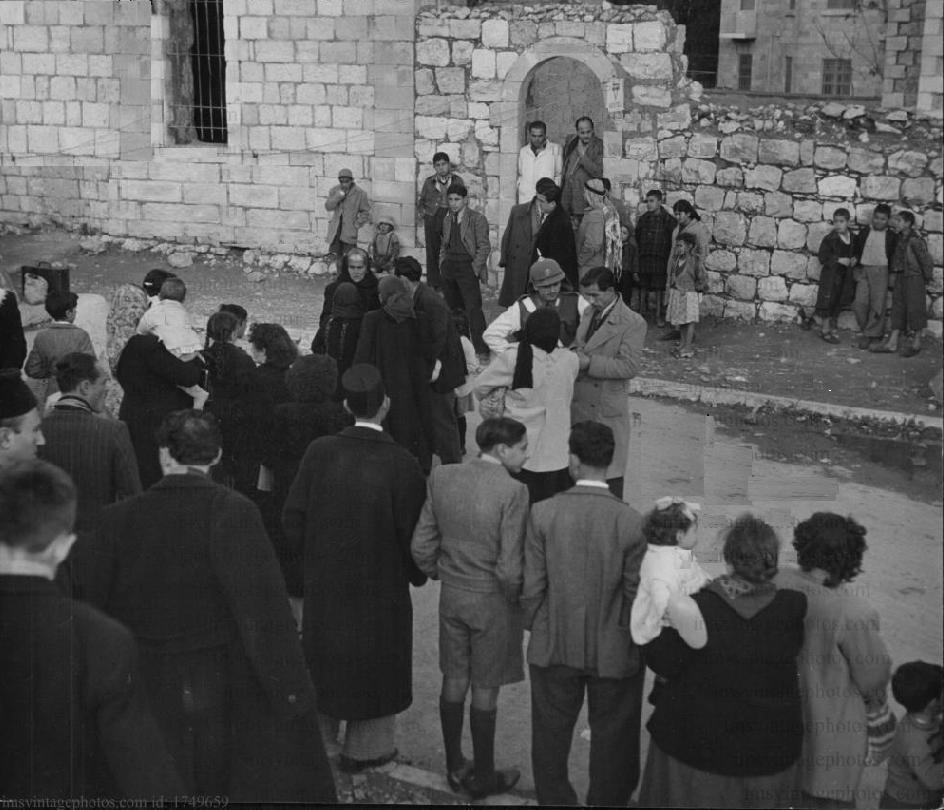
British Administration: Palestinian Mandate--Photography (1919-48)

Figure 1.-- This photograph is identified as the Mandelbaum Gate and dated 1952. It does not look like 1952, especially the German military helmet. We see people who look to be Arabs, Christians, and Jews. The clothing to us looks more like the 1930s. It is identified as the Mandelbaum Gate. It may be the Mandelbaum House but even that is confusing. Mandelbaum Gate was a military check point betweem Israel and Jordan, but here we see no guns whatsoever and nothing that looks like an Israeli or Jordaniam military uniform. So this is probanly the Mandelbaum House in East Jerusalem which was a major structure until it was damaged in the Israeli Independence War (1947-48). Just what is going on here we are not sure.
|
|
Palestine because it was the Christias Holy Land was perhaps the most photographed of all the Arab lands. And this only increased with the British mandate. The available imagery helops to illustrate what was occuring in Palestine. Sone of these iumages have captions, but even without captions we can generally create captions to bring out what the images shiw. Some of the images, however, are difficult to assess. Some we discard as having no historucal interest. Others that are interesting we load, hoping that readers may be able to offer some insights into what is being photographed.
Photo 1
This photograpoh is identified as the Mandelbaum Gate and dated 1952 (figure 1). It does not look like 1952, especially the German military helmet. We see people who look to be Arabs, Christians, and Jews. The clothing to us looks more like the 1930s. It is identified as the Mandelbaum Gate. It may be the Mandelbaum House but even that is confusing. Mandelbaum Gate was a military check point betweem Israel and Jordan, but here we see no guns whatsoever and nothing that looks like an Israeli or Jordaniam military uniform. This is probanly the Mandelbaum House in East Jerusalem which was a major structure until it was damaged in the Israeli Independence War (1947-48). The Mandelbaum House was a substantial three-story stone building that was built (1927). It was erected by a Jewish merchant Simcha Mandelbaum, who had raised his ten children in the Old City but who needed a larger home to accommodate his married children and guests. Rather than build in a Jewish populated areas like Jaffa Road or Rehavia, he chose to build on a lot at the end of Shmuel HaNavi Street close to the Third Wall from the time of King Agrippas. He wanted to set an example for other Jews to build in the area and expand Jerusalem's northern boundary. The Waqf which owned large tracts in the area, after Mandelbaum purchased his plot prohibited Arabs from selling any more land to Jews. A waqf (habous or mortmain property وقف) is as defined in Islamic Law is an inalienable charitable endowment which normally involves land or other assets being donated for Muslim religious or charitable purposes. In Palestine the concept was expanbded with the Muslim community to prohibit land sales to Jews.
As a result the Mandelbaum House stood alone as the only substantial structure. During the Arab uprisings of 1929 and 1936, the Haganah Jewish militia fortified the house to repel Arab militias advancing from the Damascus Gate toward the Jewish populated Mea Shearim and Beit Yisrael neighborhoods in Jerusalem. The House was bafly damaged in 1948.
CIH

Navigate the Children in History Website:
[Return to Main British Palestinian Mandate page]
[Return to Main Israel-Palestine 20th century page]
[Return to Main Israel-Palestine page]
[About Us]
[Introduction]
[Biographies]
[Chronology]
[Climatology]
[Clothing]
[Disease and Health]
[Economics]
[Freedom]
[Geography]
[History]
[Human Nature]
[Law]
[Nationalism]
[Presidents]
[Religion]
[Royalty]
[Science]
[Social Class]
[Bibliographies]
[Contributions]
[FAQs]
[Glossaries]
[Images]
[Links]
[Registration]
[Tools]
[Children in History Home]
Created: 2:00 AM 8/31/2017
Last updated: 2:00 AM 8/31/2017



